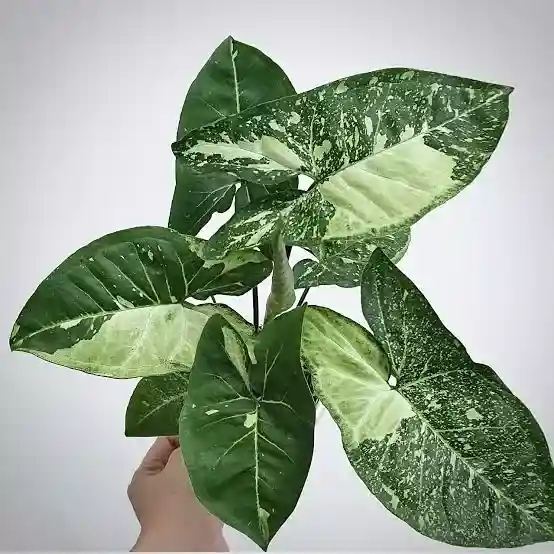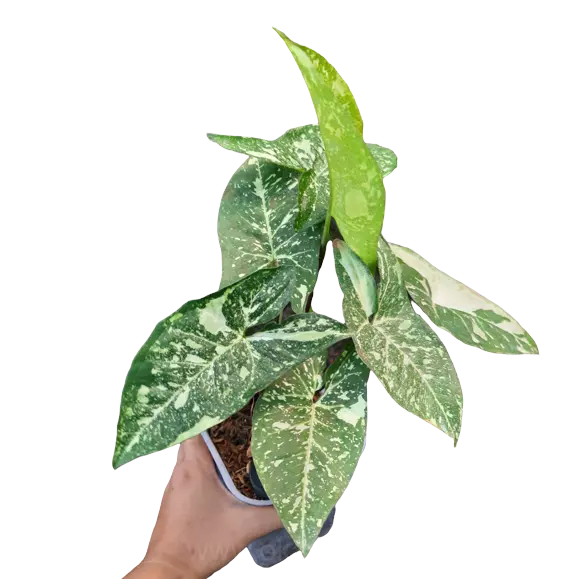Syngonium Panda Galaxy
Original price was: ₹3,200.00.₹249.00Current price is: ₹249.00.
28 in stock
Selling size: Single plant | 2.5″-4″ Pot Included
The Syngonium Panda Galaxy is a beautiful and relatively easy-to-care-for houseplant, known for its striking variegated foliage with minty-green spots and splashes on medium-green leaves.
Here’s a comprehensive guide to Syngonium Panda Galaxy‘s care:

1. Light:
- Bright, Indirect Light is Key: This is crucial for maintaining its vibrant variegation. Place it near a window with filtered light, or in a well-lit room where it won’t receive direct, harsh sunlight, especially during the hottest parts of the day.
- Avoid Direct Sun: Direct sun can scorch the leaves, leading to brown or yellow patches.
- Low Light Tolerance: While it can tolerate lower light conditions, its growth will be slower, and the variegation might fade.
- Supplemental Lighting: If natural light is insufficient, consider using a grow light, especially during winter months. A light meter can help you ensure optimal light levels.
2. Watering:
- Allow Top Soil to Dry: Water thoroughly when the top 1-2 inches (2.5-5 cm) of soil feel dry to the touch.
- Avoid Overwatering: Syngoniums are susceptible to root rot if the soil stays soggy. Ensure proper drainage.
- Don’t Let it Dry Out Completely: While it prefers to dry out between waterings, don’t let the potting medium become bone dry, as this can lead to brown leaves.
- Watering Frequency: This will vary with the season and light. In warmer months (spring and summer), it will need more frequent watering than in winter when its growth slows.
- Water Temperature: Use room temperature water.
- Drainage: Always ensure your pot has drainage holes, and discard any excess water from the saucer or cachepot.
3. Humidity:
- Tropical Plant: As a tropical plant, the Syngonium Panda Galaxy appreciates moderate to high humidity (ideally 60-80%).
- Increasing Humidity:
- Place a pebble tray filled with water near the plant.
- Use a humidifier.
- Group it with other plants to create a microclimate.
- Regularly misting the leaves can help, but it’s often a temporary solution.
4. Soil:
- Well-Draining and Nutrient-Rich: A crucial aspect to prevent root rot. The soil should mimic its natural habitat, being light and porous.
- Recommended Mix: A good mix typically includes:
- 2 parts well-draining potting mix (with peat moss, perlite, and/or vermiculite)
- 1 part organic compost
- 1 part perlite or vermiculite for added drainage and aeration.
- Some growers also recommend adding a small amount of orchid bark for acidity and activated charcoal to filter impurities.
- Slightly Acidic: Syngoniums thrive in a slightly acidic soil, with a pH range of 5.5 to 6.5.
5. Temperature:
- Ideal Range: Maintain a temperature between and ( and ).
- Avoid Extremes: Protect the plant from drafts and sudden temperature fluctuations.
6. Fertilization:
- During Growing Season: Feed with a balanced liquid houseplant fertilizer every 2-4 weeks during spring and summer (active growing season).
- Reduce in Winter: Decrease the frequency of fertilizing in autumn and winter when the plant’s growth slows.
- Slow-Release Options: A slow-release fertilizer applied every 3-4 months can also be beneficial, supplemented with occasional organic feeds like worm castings for micronutrients.
- Avoid Over-fertilizing: Too much fertilizer can burn the roots. Always follow product instructions.

7. Pruning:
- Maintain Shape and Bushiness: Syngoniums are natural climbers and can become leggy. Prune to encourage bushier growth and maintain a desired shape.
- Remove Damaged Leaves: Regularly trim any yellow, brown, or damaged leaves to promote overall plant health and appearance.
- Propagate Cuttings: Pruning provides excellent opportunities for propagation.
8. Syngonium Panda Galaxy Support (Optional but Recommended):
- Climbing Habit: Syngoniums prefer to climb in their natural habitat. Providing a moss pole or other support will encourage larger leaves and a more upright growth habit.
9. Pests and Diseases:
- Common Pests: Keep an eye out for common houseplant pests like spider mites, aphids, thrips, and mealybugs.
- Treatment: If you spot pests, promptly treat them with insecticidal soap or neem oil solution.
- Good Airflow: Ensure good air circulation around the plant to help prevent fungal issues.
10. Repotting:
- Every 1-2 Years: Repot your Syngonium every 1-2 years, or when you see roots emerging from drainage holes or the plant appears root-bound.
- Choose a Slightly Larger Pot: Select a pot that is roughly 2 times the size of the original nursery pot, ensuring it has drainage holes.
11. Syngonium Panda Galaxy Propagation:
- Easy from Cuttings: Syngoniums are very easy to propagate from stem cuttings.
- Steps for Water Propagation:
- Cut a healthy stem that includes at least one node (where leaves or aerial roots emerge) and one or two leaves.
- Remove any lower leaves that would be submerged in water.
- Place the cut end in a jar of clean water.
- Change the water every few days to prevent bacterial growth.
- Roots should start to grow within a few weeks.
- Once roots are at least 1-2 inches long, you can transfer the cutting to a well-draining potting mix.
- Other Methods: Cuttings can also be rooted directly in sphagnum moss or a light soil mix.

By following these care guidelines, your Syngonium Panda Galaxy should thrive and reward you with its stunning foliage! Remember that each plant is unique, so observe your plant closely and adjust its care as needed.
Only logged in customers who have purchased this product may leave a review.












 If you need any assistance, I'm always here. Have you found what you were looking for?
If you need any assistance, I'm always here. Have you found what you were looking for?
Reviews
There are no reviews yet.